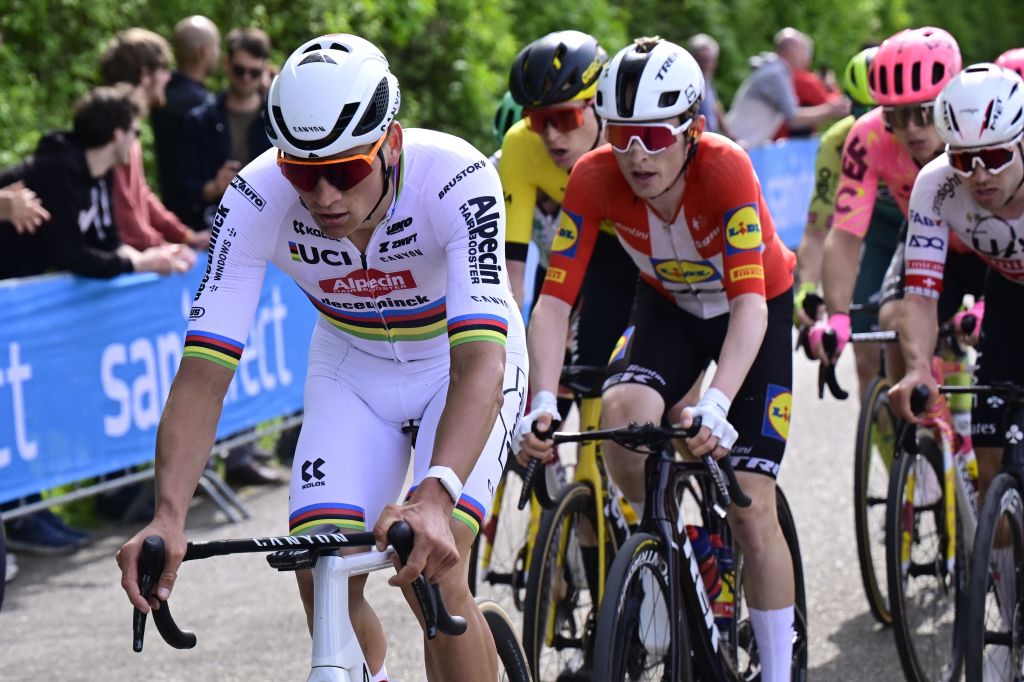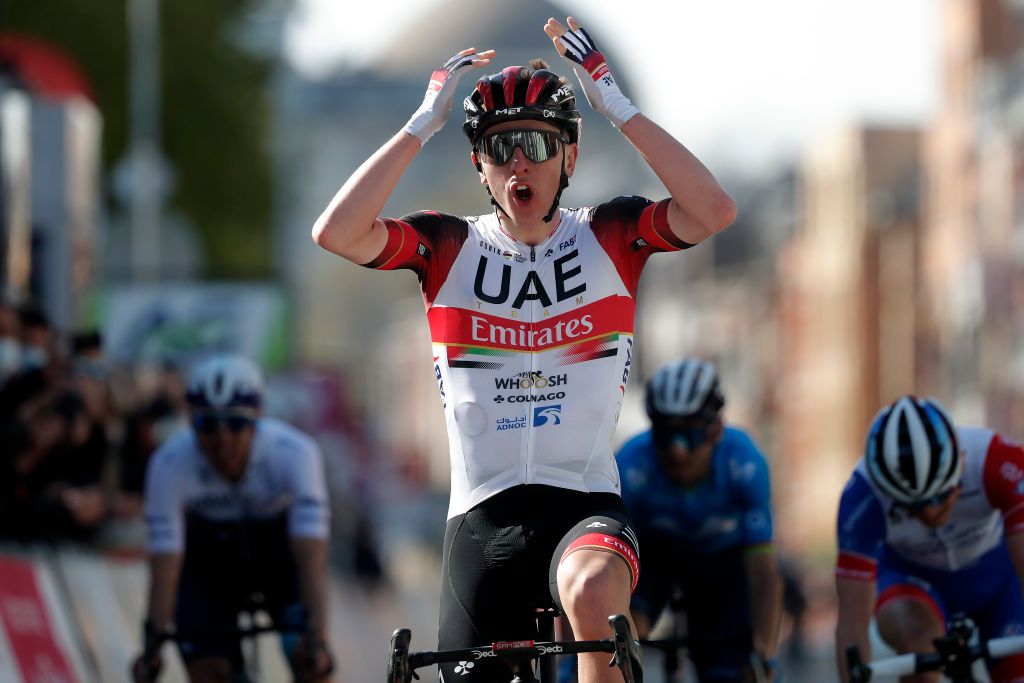He has yet to put it like that himself, but if Tadej Pogačar is looking on his upcoming ride in Liège-Bastogne-Liège partly as a chance to complete some unfinished business, nobody would be that surprised.
After all, last year the oldest Monument of them all was where everything that had gone so right for Pogačar until that point suddenly went askew. Some 85 kilometres into the race, a chance entanglement in a crash, sparked when EF Education-EasyPost racer Mikkel Honore suffered a double puncture on a downhill, saw the Slovenian fall heavily.
His teammates stopped, almost as a default reaction, to see if they could pace the UAE leader back into the game.
But the state of one of Pogačar’s wrists, later revealed to have multiple fractures, meant the only direction the UAE Team Emirates rider was heading from that hillside somewhere in the southern Belgian Ardennes was towards an operating table at Genk hospital.
To say Pogačar’s untimely exit from Liège had the effect of an earthquake on professional cycling was hardly exaggerating.
Until that point in 2023, barring near-misses at Milan-San Remo and E3 Harelbeke, Pogačar had won every race he had taken part in. He had beaten Mathieu van der Poel and Wout van Aert on their own terrain in the Tour of Flanders, and he had conquered Paris-Nice in his first ever participation. After taking Amstel Gold and Fleche Wallonne, he looked to be well en route to a possible Ardennes triple.
Suddenly, and in the most dramatic of circumstances, the rider seemingly operating in a different dimension to the rest of the peloton for the first five months of 2023 had disappeared from the radar.
The latest race content, interviews, features, reviews and expert buying guides, direct to your inbox!
Questions about Pogačar’s road to the Tour de France were already being raised even before UAE manager Mauro Gianetti told media at the finish in Liègethat the operation required by his rider would be “complicated.”
The most far-reaching part of the domino effect of consequences only emerged in the third week of the Tour de France, with Pogačar’s memorable radio message to his team on the Col du Loze – ‘I’m gone, I’m dead.’ That was the final confirmation that after three months of less-than-perfect preparation as a result of the crash, his bid to counter Jonas Vingegaard’s second straight victory had run out of steam.
When it came to the short-term shockwaves from his crash, fans of Liège had to accept that the much-anticipated prospect of Pogačar taking on Remco Evenepoel in one of cycling’s most prestigious one-day races had abruptly evaporated.
Rather make than a long-distance attack a la Bernard Hinault through the snows of Liege in 1980, or repeat the memorable duel of Michele Bartoli and Frank Vandenbroucke on the Cote de la Redoute in 1999 – each rider staring fixedly ahead, battling side by side – the expected showdown suddenly became a one-man show.
For Evenepoel, waving his arms repeatedly to urge the crowd to yet greater applause as he rode up the Boulevard de Sauveniere in Liege, his second straight victory, clad in the jersey of world champion, represented a huge success and simultaneously ‘saved’ QuickStep’s Classics season for a second year running. But nobody could forget what had happened 200 kilometres earlier. And it was tempting to wonder, too, how the race might have played out had Pogačar stayed upright.
Liège-Bastogne-Liège 2024
Pogačar returns in 2024, eager to claim his second win at La Doyenne after his triumph three years ago. This Sunday, the section of road on the outward segment of the course towards the city of Bastogne where Pogačar fell has been switched out for an alternative southerly route, and as a consequence, the Côte de Roche-en-Ardenne, traditionally the first of the 11 ascents, has been substituted for the Côte de Bonnerue.
In the bigger scheme of things, and with no TV coverage of that part of the race, the change will hardly be noticed. For Pogačar and the rest of the peloton, it’s the ten climbs after Bastogne that always matter, in particular the trio of the Wanne, Stockeu and Haut Levée, before the culminatation over the Côte de la Redoute, Forges and – above all – the Côte de Roche-aux-Faucons.
For Pogačar, even without all of the events of 2023 looming large over his Liège participation this Sunday, and regardless of what he achieves, La Doyenne is a milestone. He has already won Strade Bianche and dominated the Volta a Catalunya in a Spring where he sacrificed the cobbled Classics to focus on preparations for the Giro d’Italia.
Liège traditionally marks the point where the curtain drops on the Classics and cycling begins to look towards the Grand Tours in earnest. In the Slovenian’s case, with a double Grand Tour challenge just two weeks away. The 25-year-old’s performance in Liège, his last race before the Grande Partenza in Turin on May 4, will be the key reference point for what could be to come on the roads of Liguria, Tuscany and the Alps next month.

Van der Poel
Regardless of what this means for Italy, victory for Pogačar in Liège would put a sixth Monument title on his palmares. If last year the prospect of a Pogačar-Evenepoel duel was keenly anticipated by bike racing fans across the globe, this time Liège is an opportunity to see the Classics giant of the 2024 season, Mathieu van der Poel face off against the UAE Team Emirates star.
Obviously, other riders of the calibre of Amstel Gold winner Tom Pidcock (Ineos Grenadiers) or Mattias Skjelmose (Lidl-Trek) will do their utmost to nudge theirn way into the picture on Sunday, and if the weather continues to be as cold and unforgiving as it was in Flèche Wallonne, the options for an unpredictable race, perhaps even an early break sticking all the way to the finish, rise considerably.
But it remains tricky, at least for now, to see beyond the battle between Pogačar and the rider who has already been the first in a decade to win Flanders and Roubaix in the same season, and who is now seeking to be the first since Sean Kelly in 1984 to win Roubaix and Liège in the same spring. He is also seeking to become the only the second rider to win three Monuments in a season, a feat achieved by Eddy Merckx in 1969, 1971, 1972 and 1975.
What makes the duel all the more intriguing, of course, is that both riders’ form is something of an unknown. Pogačar has spent three weeks training at altitude at Sierra Nevada in the south of Spain and if the weather was atrocious in that first week, he also avoided the cold and fatigue of the rain-soaked La Fleche Wallonne.
Van der Poel, on the other hand, comes to Liège at the end of a Spring Campaign that has been low on race days (three fewer, in fact, than Pogačar) but high on intensity, and where his uneven performance in Amstel Gold raised questions about whether his top Classics form can endure for one more (probably) rainy Sunday in the Ardennes. He has already said too, that he will be facing riders who can climb better than him, no small matter in a race with as much vertical climbing (around 4,000 metres) as a Tour de France mountain stage.
The two top names of Liège-Bastogne-Liège enter the race after radically different approaches, then, and with very different backstories for the event itself. Van der Poel’s one previous participation in 2020 netted him a respectable sixth place, while Pogacar’s track record is third in 2020, a win in 2021 and an abandon in 2023. But regardless of the outcome for Pogačar, the sense that one chapter will close on Sunday afternoon in Liege and another open is all but inescapable. Particularly when the start of his Giro-Tour double bid is now only two weeks away.
Get unlimited access to all of our coverage of the Spring Classics- including reporting, breaking news and analysis from Liège-Bastogne-Liège and more. Find out more.











